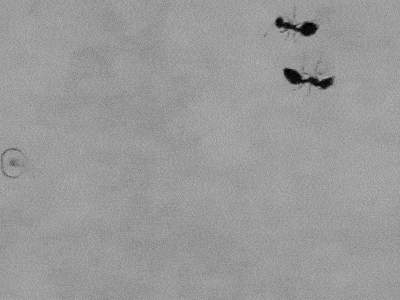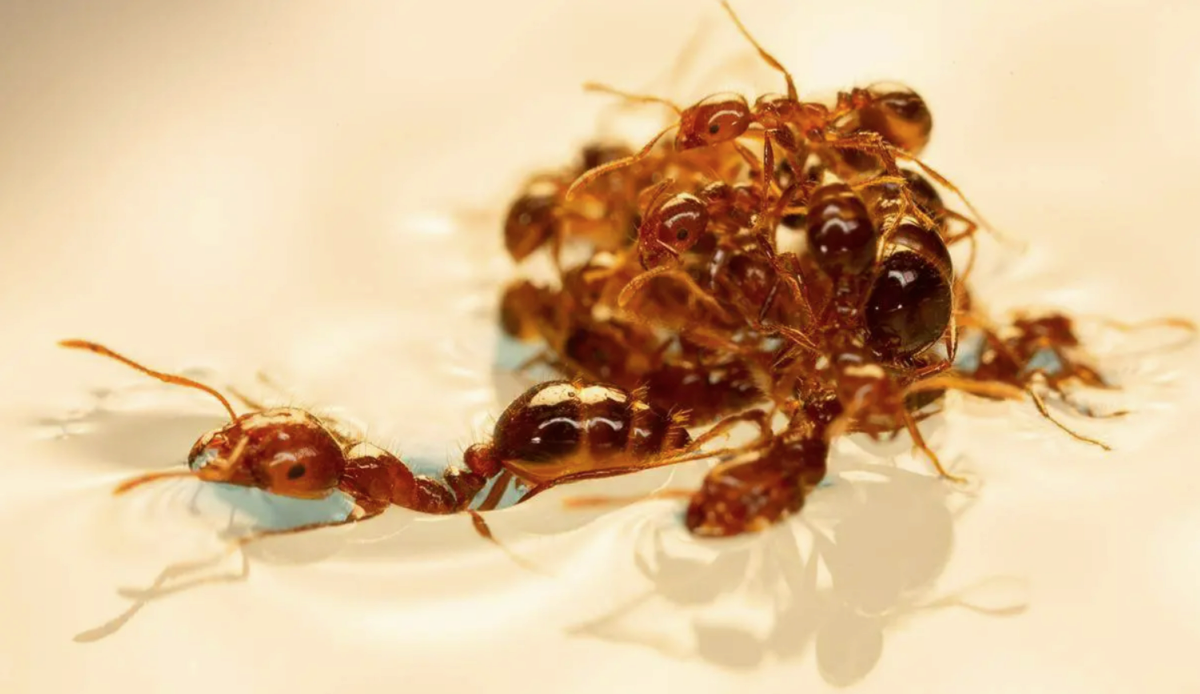
Fire Ant Rafts Form Thanks to a Force Known as the ‘Cheerios Effect’
In water, ants tend to flail and actively repel each other but are drawn together by physics
September 28, 2022
By Joshua Stewart
Ever stare at those last few pieces of breakfast cereal and watch them seemingly clump together or cling to the side of the bowl?
Scientists have dubbed it the “Cheerios effect,” the combination of forces causing those clumps. Researchers at Georgia Tech have discovered those same forces draw small numbers of ants together to begin to form water-repellent ant rafts — even though the ants seem to be uninterested in collaborating with their neighbors for survival.
 Described in the journal Physical Review Fluids, their study explains for the first time the underlying forces at play in attracting ants to each other. Ants clump together into rafts to survive during flooding, and the team determined it takes exactly 10 ants to form a stable raft.
Described in the journal Physical Review Fluids, their study explains for the first time the underlying forces at play in attracting ants to each other. Ants clump together into rafts to survive during flooding, and the team determined it takes exactly 10 ants to form a stable raft.
“The motivation here was to understand how these individual parts come together,” said Hungtang Ko, a mechanical engineering Ph.D. student in Professor David Hu’s lab and first author of the study. “We looked at how a pair of ants interact, and we were surprised to find that they don't actually actively swim towards each other. Even when they do, they tend to repel or ignore the other ant.”
Studying small groups of ants — down to just a pair of individuals — the team found they flail their legs when placed in water and bounce off each other. Yet, inexorably, the Cheerios effect draws them together.
Hu and his lab have long studied how fire ants weave themselves into tight, water-resistant rafts for survival. They can float atop water for weeks at a time — like huge colonies in Houston after Hurricane Harvey that drew national attention. Hu has documented that ants in these rafts create connections with an average of 14 others to form their water-repelling seal. Groups also can build towers to escape rising water.
Usually, studies of rafts involve 1,000 or more ants. This time, the team scaled down to a few as two to understand the mechanism behind raft formation.
“I think the surprising thing here is that ants prioritize exploration, actively avoiding each other on the water surface. They instead rely on physical forces to bring them together — the Cheerios effect,” said Hu, professor in the George W. Woodruff School of Mechanical Engineering and the School of Biological Sciences. “Previously, we only studied the change in the shape of the raft once formed; we never asked how ants find each other on the water surface.”
Just like those lingering Cheerios in milk, the ants float atop water. They’re not heavy enough to break the surface tension and sink, but they create a slight depression in the water’s surface. At its most basic, the slope of those depressions causes nearby ants to “slide” down next their neighbor. That’s the Cheerios effect.
“The Cheerios effect scales with number, so the larger the raft, the easier it is for satellite ants to get attracted to it and the harder it is for ants to escape the raft’s influence,” said Ko, now a postdoctoral fellow at Princeton University.
Ko and the team also found the tipping point for a stable raft is when 10 ants clump together. Any fewer and the rafts break apart within minutes as the ants flail. Time is a factor, too. The longer ants are on the water, the less active they become.
“Being apart is not beneficial for their survival, but it turns out that it takes time for them to realize that this is a friend not a foe, and they shouldn't have pushed them away,” Ko said. “When you just first put them in water, they’re all frantic and waving their arms. That craziness decreases with time, especially when they're in a stable raft, and slowly they come to realize that maybe they'll start to form more rigid and stable connections.”

Birds, fish, and other organisms exhibit this kind of grouping behavior, but little is known about how they do amazing things as a group that the individuals don’t do, Hu said: “This study is about their coherence — the ability of the members to stay together.”
Ko said that’s what makes collective behavior so fascinating. The collective is usually greater than the sum of its parts.
“An individual fish or bird has limited abilities to escape predators, but when they come together in groups, they can perform evasive tactics as a team plus many more fascinating tasks,” Ko said. “And this extends beyond animals. Air molecules individually only obey so many laws, but when they come together, they can flow like a fluid. There are all kinds of complex weather phenomena that arise from the individual interactions.”
